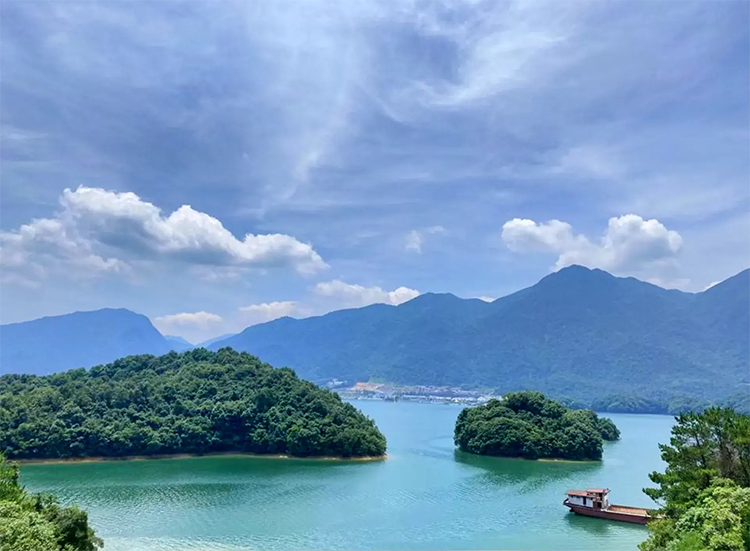Explore Yunju Mountain and Lushan West Sea: The Thousand-Island Lake of Tranquil Beauty
When dawn breaks through the clouds over Zhelin Lake, 1,667 jade-like islands emerge from the mist like an overturned board of emerald game pieces. This is Lushan West Sea (Xihai), celebrated as one of China’s most beautiful lake-and-mountain landscapes—a place where a millennium of Buddhist calm, classical Chinese poetry and ecological wonder converge. Across a 680 km² canvas you can boat among tiny pink “peach-blossom” jellyfish, follow in Su Shi’s footsteps at Tang- and Song-era rock inscriptions, and experience the hush of morning bells at Zhenru Chan Temple—an Eastern meditation on silence and sound.
1. Ecological Miracle of a Thousand Islands
Zhelin Lake’s 308 km² of open water forms a natural palette: lake clarity often exceeds 7 meters, meeting China’s top drinking-water standard. Cruising by boat through the scattered islands reveals three linked color experiences: crystal-clear water nearby, Tiffany-blue ripples mid-distance, and distant mountains in ink-blue silhouettes. From May to September, the globally rare pink peach-blossom jellyfish (only about 2 cm across) aggregate in large numbers—best observed in the lake’s central Gongbei waters.
2. Yunju Mountain: A Hill of Tang–Song Elegance
Rising to 1,143 meters, Yunju Mountain has been a literary and spiritual magnet since the Tang dynasty. On a mountain hike you’ll encounter three major cultural highlights:
– Zhenru Chan Temple: Founded in 806, this exemplary Buddhist monastery preserves the Tang layout of the seven temple halls and houses more than 30 stupa tombs of eminent monks—a living, three-dimensional history of Chinese Buddhist architecture.
– Zhaozhou Pass: A well-preserved Song-era mountain pass, its stone face bears Bai Juyi’s verse “In the deep ridges the Yunju road winds,” particularly majestic amid autumnal red leaves.
– Cliff Inscription Gallery: Over 130 inscriptions line the path; the crown jewel is Su Shi’s original calligraphy for “Visiting Yunju Temple,” whose strokes echo the mountain’s rises and falls.
3. A Four-Season Natural Theater
Spring (Mar–May): Rhododendron seas paint the slopes red.
Summer (Jun–Aug): Average lake-side temperatures hover around 22°C—nature’s own air conditioning.
Autumn (Sep–Nov): A blaze of color and intermittent sea-of-clouds spectacles.
Winter (Dec–Feb): Rime and temple red walls create ink-wash scenes.
Photography tips:
– Best sunrise: Zhelin Lake Viewing Pavilion (arrive before 5:30 a.m.).
– “Buddha’s light” phenomena: mornings with mist—observe before 10:00 a.m.
– Peak red-leaf period: roughly Nov 10–25 each year.

4. Practical Deep-Visit Guide
Transportation:
– By car: About 1.5 hours from Nanchang Changbei Airport via Fuyin Expressway.
– By train + bus: Alight at Yongxiu Station and transfer to the hourly tourist shuttle.
Recommended routes:
– Classic one-day: Visitor Center → lake loop boat tour (3 hrs) → Zhenru Chan Temple (2 hrs) → Zhaozhou Pass (1 hr).
– Immersive two-day: Day 1: Zhelin Lake ecological study and lakeside homestay. Day 2: Yunju Mountain hike and meditation session.

Practical tips:
– Tickets: High season (Mar–Nov) CNY 150 (includes boat); low season CNY 120.
– Local specialties: Zhelin fish head stew (made from lake carp) and Yunju Mountain vegetarian cuisine.
– Stays: Choose the Zen Manor (antique courtyard-style) or book a lakeside houseboat—reserve at least one month in advance.
When the last slant of sunset gilds the cliff inscriptions, you’ll understand why generations of poets called this place a “mountain-and-water Zen beyond the dust.” Lushan West Sea is not merely scenery to be seen: it’s a cultural practice to be felt. Each island is a punctuation mark; every ripple, a verse—waiting for you to write your own Eastern poem.


